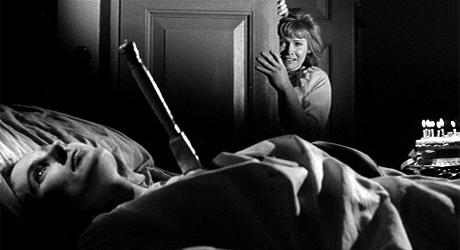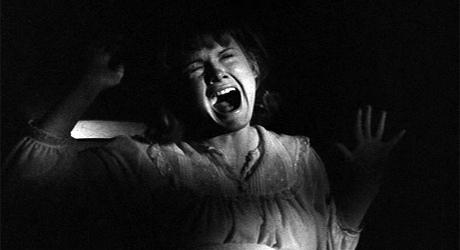
by Steve Habrat
Despite what you may believe, Hammer Films didn’t only fiddle with gothic horror films about vampires, werewolves, Frankenstein monsters, and mummys. In the wake of Alfred Hitchcock’s psychological horror film Psycho, studios began rushing to capitalize on the formula Hitchcock used to such shocking effect in 1960. Hammer was certainly no different, and among the Psycho-inspired films that they sent down the assembly line was the claustrophobic Nightmare, a spine-tingling psychological horror movie presented in noir-like black and white. Without an undead fiend to terrorize Peter Cushing or a busty woman in a low cut dress, many might be quick to dismiss Nightmare as a bit of a disappointment, especially since some of Hammer’s finest moments have been with Frankenstein or Dracula, but under the direction of studio regular Freddie Francis, Nightmare is an arresting exercise in spectral spooks and slasher brutality. It also happens to be an extremely gorgeous looking horror movie, one that features undeniably pristine cinematography and expert lighting effects to give the film quite a bit more bite than it already has.
Nightmare introduces us to Janet (played by Jennie Linden), a young woman who suffers from terrible nightmares that send her from her bed screaming bloody murder every single night. As a young girl, Janet accidentally witnessed her deranged mother stabbing her father to death, laughing all the while she plunged the knife into his chest. Now all grown up, Janet is enrolled in a boarding school, but her nightmares have grown so severe that one of her teachers, Mrs. Lewis (played by Brenda Bruce), convinces the school to send her home to her guardian, attorney Henry Baxter (played by David Knight). Upon arriving home, Janet meets her new nurse, Grace Maddox (played by Moira Redmond), chauffeur John (played by George A. Cooper), and housekeeper Mrs. Gibbs (played by Irene Richmond), but shortly after settling in, her nightmares begin and it also appears that she is suffering from disturbing hallucinations. She constantly sees a corpse with a bloody knife protruding from its chest and she catches glimpses of a ghostly woman wandering the halls in a trance. Day after day, Janet is convinced that she has inherited her mother’s insanity, but after a brutal attack, she is shipped off to a hospital for serious treatment. Shortly after Janet is gone, certain members of the house begin to suspect that Janet may not have been suffering from terrible hallucinations after all.
In true Hammer fashion, Francis puts plenty of emphasis on the film’s setting and atmosphere. The film opens in a darkened sanitarium as a woman’s voice calls out to a terrified Janet, who is wandering these threatening halls unaccompanied. This journey culminates with Janet stepping into a padded cell and staring her unhinged mother right in the face. Francis quickly steps in and reminds us that it’s just a nightmare, but judging from the screams of the poor Janet, these dreams are pushing her fragile state to the breaking point. It should be noted that anytime anyone screams in Nightmare, the sound work on the shrieks will have you frozen in horror. The screams that the characters emit could shatter concrete. After we emerge from the sanitarium of terror, Francis gives us a small break before he drops us into another house of horror. Cramped with lavish furniture and engulfed by heavy shadows cast down hallways and in bedrooms just down the hall, there seems to be no escape for poor Janet. Every night before she settles in for bed, she hears a faint noise that lures her away from her bed. She bumps into a woman wearing a white gown and sporting a nasty scar on her cheek and she discovers a corpse that has been hacked and slashed to death. Each scare is executed with precision and the claustrophobic goth that wraps around us makes Nightmare unshakeable.

While Nightmare doesn’t enjoy the presence of Peter Cushing, Christopher Lee, or even Oliver Reed, Francis still manages to capture some rock-solid performances that are sure to keep you entertained. Linden is perfect as the young, sympathetic Janet who just wants her night terrors to cease. Her final push into violence is made all the more disturbing through the fact that she had so much innocence in her heart. Redmond puts on a kindly face as Janet’s new nurse, Grace, but as the horror progresses, we realize that there is a dark side lurking deep down within her just waiting to emerge. Knight is charismatic as Janet’s guardian, Henry Baxter, who perks the young girl up just by walking into her bedroom. Irene Richmond and George A. Cooper is in supporting roles as John and Mrs. Gibbs, but in the end, Francis and screenwriter Jimmy Sangster give them the opportunity to play hero to the violence and madness overtaking the mansion. Brenda Bruce is another warm and caring force as Mary Lewis, Janet’s concerned teacher who thinks it’s best if she spends some time at home. Probably the strongest performance in Nightmare Isla Cameron as Mother (that sounds very Psycho to me…), who smiles as she waves a knife around and seems to find enjoyment in her daughters horrified screams for help.
Considering that Nightmare was riding the wave of Psycho’s popularity, there are a few little similarities that the viewer just can’t turn a blind eye to. First is the twist that is pulled at the end, something that won’t be revealed here, but that is indeed strikingly similar to some parts of Hitchcock’s slasher. There is also the fact that our main character, Janet, disappears halfway through the movie, something that is glaringly similar to Janet Leigh’s Marion Crane (luckily, Hammer didn’t decide to stab her to death in a shower). This lift could have been disastrous, but luckily, Sangster writes up supporting characters that can carry the film when Janet steps out. Overall, if you have had your fill of watching Van Helsing drive stakes through the heart of Dracula, or you need to break from watching Victor Frankenstein reanimating lifeless flesh, Nightmare offers a nice change of pace for Hammer fans. It doesn’t push the limits of the horror of personality subgenre (Hitchcock still remains the master) and it has been unfairly overshadowed by the studio’s color monster movies, but it does give the psychological horror film a heavy gothic makeover, throws in some “ghosts,” and petrifies anyone who hates creepy old dolls. Bonus points for the rich use of black and white film.
Grade: B
Nightmare is available on DVD.
